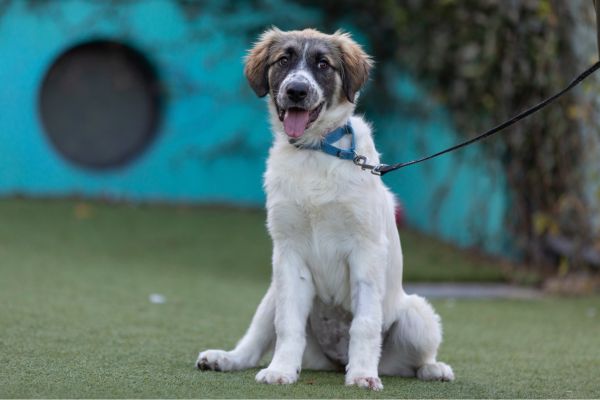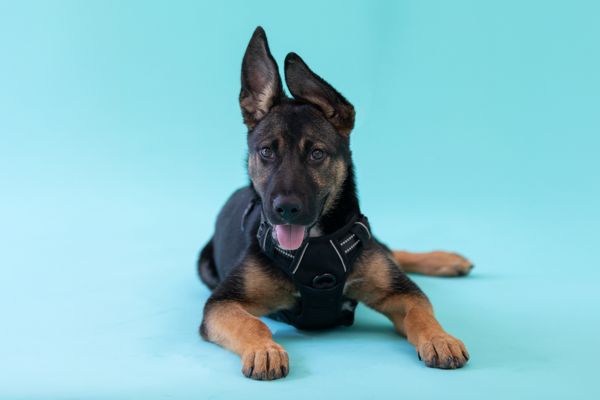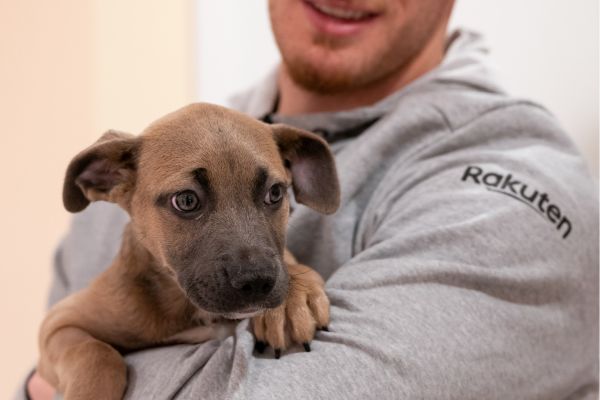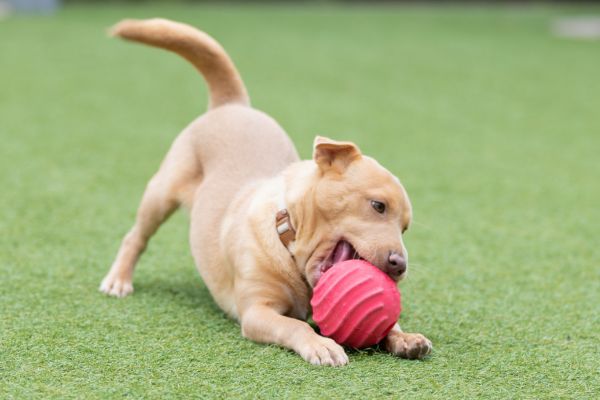Bringing home a new puppy is exciting and a little overwhelming. From potty training to teaching good manners, your puppy is learning how to live in your world, and it’s up to you to guide them with patience and kindness. With consistency, supervision, and plenty of rewards for good behavior, your puppy will quickly learn what’s expected of them, setting the stage for a lifetime of good habits and happy companionship.
In this guide, we’ll cover the basics of sit, stay, house training, biting, crate training, chew training, and socialization to help you and your puppy start off strong.

Teaching basic commands
Teaching your puppy basic commands like sit and stay is essential for fostering good manners and building a foundation for future training. These commands help your puppy navigate everyday situations, making life easier for both of you—whether it’s greeting guests, waiting patiently for dinner, or staying calm in public places.
The sit command is often the first command behavior puppies learn. Teaching your puppy to sit on cue helps prevent jumping during greetings and encourages polite behavior. Over time, sit becomes a default polite behavior, giving you a simple way to manage your puppy’s excitement or energy in any situation.
The stay command is equally valuable, teaching your puppy impulse control and patience. Stay can be especially helpful when guests arrive, during mealtime, or when you need to complete a task without your puppy underfoot. It also comes in handy in public settings, like patios or parks, where having your puppy remain calmly in place makes outings more enjoyable for everyone.
A few tips for sit and stay success:
- Use high-value treats (like chicken or cheese) to keep your puppy motivated and be consistent with your cues.
- Avoid repeating the command multiple times—say it once and reward the correct response. If your puppy struggles, go back a step and practice until they succeed.
- Most importantly, keep training sessions short and positive, so your puppy stays engaged and excited to learn.
- With practice, sit and stay will become second nature, helping your puppy grow into a well-mannered and responsive companion.

House training
House training takes time, patience, and consistency. Every puppy learns at their own pace, depending on their age, size, and individual habits, so it’s important to stay diligent and keep a clear routine. House training a puppy can take anywhere from a few weeks to several months before your puppy is reliably house-trained.
The key to successful house training is supervision. Until your puppy is fully trained, never leave them unsupervised in your home unless they are safely in their crate. Here are some tips for house training your puppy:
- Take your puppy outside frequently, starting with every 30 minutes and gradually increasing the time between outings. Young puppies, especially those around eight to ten weeks old, may need bathroom breaks as often as once an hour, as well as after meals, naps, play sessions, and right before bedtime.
- When your puppy does their business outside, praise and reward them with a treat to reinforce the behavior.
- If you catch them starting to have an accident indoors, interrupt without scolding—a sharp “Ah! Let’s go outside!”—then immediately take them to their designated spot. If they finish outside, offer praise and a treat.
- Never punish your puppy for accidents, especially if you didn’t witness it happening. Puppies don’t understand punishment after the fact, and it may cause them to hide their accidents instead of learning where to go.
As your puppy gets older (around three months of age), you can slowly increase the time between outings, adding an hour every week or two. If accidents start happening again, simply go back to more frequent potty breaks for a while before trying to extend the time again. With consistency and positive reinforcement, your puppy will soon understand where to go, and you’ll be one step closer to having a house-trained companion.

Biting and mouthing
Biting and mouthing is completely normal as puppies explore the world around them. However, those sharp little teeth can make playtime painful. Without guidance, puppies won’t know how to control their bite strength. Teaching your puppy bite inhibition (how to use their mouth gently) is key to preventing problem behavior as they grow up.
Some tips for teaching puppies not to bite:
- Redirect your puppy to an appropriate chew toy whenever they start biting your hands, clothing, or shoes. Make the toy exciting by waving it around, making it squeak, or tossing it to grab their attention.
- If they engage with the toy instead of you, praise and reward them. But if they bite too hard, calmly say “ouch!” in a sharp (but not frightening) tone and turn your back or step away for 20 seconds. This teaches your puppy that rough play means the fun stops.
- Consistency is key and always give the same feedback when your puppy bites too hard.
- Avoid any form of physical punishment, like holding your puppy’s muzzle or yelling at them, as this can increase fear and aggression.
- Focus on teaching your puppy what’s acceptable by rewarding gentle play and redirecting rough behavior. Providing plenty of chew toys, exercise, and mental stimulation will also help reduce biting out of boredom or excess energy.
With patience and consistent redirection, your puppy will learn to use their mouth gently, setting them up to be a safe and well-mannered adult dog.

Crate training
Crate training is one of the most effective tools for raising a well-behaved puppy. A crate can serve as a safe, cozy space for your puppy while also helping with house training, chew training, and settling when they’re alone. It also prepares them for situations where crate confinement may be necessary, such as during travel or veterinary visits. When introduced properly, a crate becomes a place of comfort—not punishment—for your puppy.
Start by choosing a crate that’s just large enough for your puppy to stand up, turn around, and lie down comfortably. If the crate is too big, your puppy may be tempted to use one end as a bathroom and the other as a bed. The goal is to help them understand that the crate is their resting place, not a potty spot.
Tips for getting started with crate training:
- To help your puppy form positive associations with the crate, start slow. Toss a few treats inside and praise them when they go inside.
- Once they’re comfortable stepping inside, practice closing the door briefly while offering treats through the opening, then let them back out after a few seconds.
- Gradually increase the time they spend inside by offering a stuffed KONG® or chew bone to keep them occupied. Begin leaving the room for short periods and gradually extend your absences as your puppy grows more comfortable.
- If your puppy whines or barks, avoid letting them out until they’ve been quiet for a few seconds. This teaches them that calm behavior earns freedom, not fussing. For short errands, like grabbing the mail or watering the garden, leave your puppy in the crate with a special treat to reinforce that being alone is a positive experience.
Always remember that a crate is not a long-term confinement solution. Puppies should not be crated for more than three to four hours at a time, except overnight. With consistency and patience, your puppy will learn to view their crate as a safe, cozy retreat.

Chew training
Chewing is a natural behavior for puppies—it helps them explore their world, soothe teething discomfort, and release energy. However, without guidance, your puppy won’t know the difference between a chew toy and your favorite pair of shoes.
To set them up for success with chew training, start by puppy-proofing your home, just as you would for a toddler. Keep tempting, chewable items like shoes, cords, and remote controls out of reach, and provide your puppy with plenty of appropriate chew toys. Food puzzle toys, like frozen KONGs® filled with treats or sturdy chews like bully sticks or marrow bones, are excellent options to keep them engaged.
Consistent supervision is key. When your puppy is out of their crate, keep a close eye on them. If they start chewing something they shouldn’t, interrupt and redirect their attention to a toy or chewy, then praise them for making the right choice. With time, patience, and consistency, your puppy will learn what’s theirs to chew and what’s not.

Puppy socialization
Socialization is one of the most important parts of raising a happy, confident dog. Puppy socialization is the process of introducing your puppy to new experiences, including different people, places, sounds, and other animals, so they learn to navigate the world comfortably.
The critical socialization period happens between three and 16 weeks of age, when puppies are naturally more open to new experiences. Positive encounters during this time can shape your puppy into a friendly and adaptable adult dog, while negative or missed experiences may lead to fear or anxiety as they grow up.
Tips for socializing your puppy:
- To help your puppy build confidence, expose them to a wide variety of people, including children, people in uniforms, or individuals using wheelchairs or crutches, as well as different environments, like busy streets, parks, or noisy stores.
- Always make new experiences positive and rewarding. Offer treats and praise when they approach something unfamiliar or potentially scary, like a loud garbage truck or a person wearing a hat.
- Never force your puppy into a situation they find overwhelming; instead, give them space and let them approach at their own pace.
You don’t have to wait until your puppy is fully vaccinated to begin socializing. Carry them in your arms, place them on a blanket at an outdoor cafe, or take them on car rides to experience the world. Attending puppy classes and social events is another excellent way to expose them to other dogs and people in a controlled setting. The more positive experiences your puppy has early on, the more likely they’ll grow into a relaxed and confident companion.
Learn more about training and caring for your new puppy in our Puppy Adoption Handbook.
